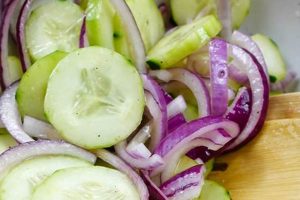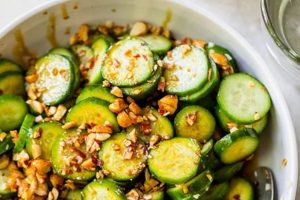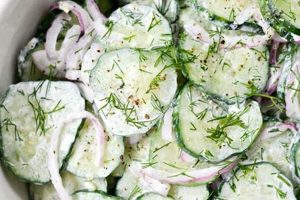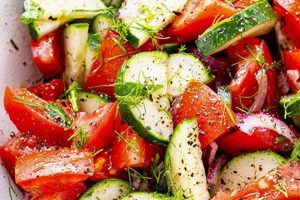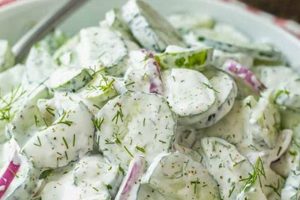A refreshing and flavorful dish, typically composed of thinly sliced cucumbers and onions, often combined with a vinegar-based dressing. Variations can include additions such as herbs, spices, or other vegetables, offering diverse flavor profiles and textures. A simple example includes thinly sliced cucumbers and red onion marinated in a mixture of white vinegar, sugar, and salt.
This type of salad provides a light and healthy accompaniment to various meals, offering a crisp and cooling counterpoint to richer dishes. Historically, cucumbers have been valued for their hydrating properties and have been incorporated into culinary traditions across the globe. The combination with onions adds a pungent layer of flavor, further enhancing the palate experience. Its simplicity makes it accessible to cooks of all levels, while its versatility allows for customization based on individual preferences and seasonal ingredients.
The following sections will explore variations on this classic dish, ranging from traditional preparations to innovative adaptations, covering ingredient selection, preparation techniques, and serving suggestions. Further exploration of nutritional benefits and historical context will also be provided.
Tips for a Perfect Cucumber and Onion Salad
Achieving optimal flavor and texture requires attention to detail throughout the preparation process. The following tips offer guidance for creating a truly exceptional salad.
Tip 1: Salt the Cucumbers: Salting sliced cucumbers draws out excess moisture, preventing a watery salad. Place the cucumber slices in a colander, sprinkle with salt, and let them sit for 15-20 minutes before rinsing and patting dry.
Tip 2: Thinly Slice the Vegetables: Uniformly thin slices ensure even marinating and a pleasant texture. A mandoline slicer or sharp knife is recommended for best results.
Tip 3: Choose the Right Onion: Red onions offer a sharp, pungent flavor that complements cucumbers well. Sweet onions or shallots can be used for a milder taste.
Tip 4: Balance the Dressing: A classic vinaigrette utilizes vinegar, sugar, and salt. Adjust the proportions to achieve the desired balance of sweet and tart flavors.
Tip 5: Add Fresh Herbs: Dill, mint, or parsley can elevate the flavor profile. Choose herbs that complement the overall flavor profile.
Tip 6: Chill Before Serving: Chilling allows the flavors to meld and enhances the refreshing qualities of the salad. Refrigerate for at least 30 minutes before serving.
Tip 7: Consider Texture: Toasted sesame seeds, chopped nuts, or croutons can add a satisfying crunch.
By following these tips, one can ensure a crisp, flavorful, and well-balanced salad. Attention to these details elevates a simple dish to a culinary delight.
These techniques offer a foundation for creating a variety of flavorful cucumber and onion salads. Experimentation with ingredients and dressings is encouraged to develop unique and personalized variations.
1. Fresh Ingredients
The success of a cucumber and onion salad hinges directly on the freshness of its primary components: cucumbers and onions. Fresh cucumbers offer a crisp, hydrating texture and a clean, subtly sweet flavor. Conversely, cucumbers past their prime can exhibit a mushy texture and a bitter taste, detracting significantly from the final product. Similarly, fresh onions provide a pungent bite that balances the cucumber’s mildness, contributing to the salad’s overall flavor profile. Onions that have begun to soften or sprout lose their sharpness and can impart an unpleasant sulfurous odor. Using subpar ingredients compromises the intended refreshing and vibrant nature of the salad. For instance, a salad made with wilted cucumbers and softened onions will lack the desirable crispness and bright flavors, resulting in a less appealing and potentially unappetizing dish.
Selecting peak-season produce maximizes flavor and nutritional value. Cucumbers harvested during their peak season exhibit the highest water content and optimal sweetness. Likewise, onions harvested at the right time possess the ideal balance of pungency and sweetness. Sourcing ingredients from local farmers markets or reputable grocers increases the likelihood of obtaining truly fresh produce. Choosing firm, unblemished cucumbers with vibrant green skin ensures optimal quality. Opting for onions that are firm, dry, and free from sprouts guarantees a sharp, clean flavor. This attention to ingredient quality significantly impacts the salad’s sensory appeal, influencing both taste and texture.
Prioritizing fresh ingredients not only enhances the flavor and texture but also elevates the nutritional value. Fresh produce retains higher levels of vitamins and antioxidants, offering maximum health benefits. Furthermore, the absence of spoilage or decay minimizes the risk of consuming potentially harmful bacteria or toxins. Understanding the importance of fresh ingredients within this simple dish emphasizes the broader culinary principle of utilizing high-quality components for optimal results. This principle applies across diverse culinary traditions and cuisines, underscoring the connection between ingredient quality and overall dish quality.
2. Proper Slicing Technique
Proper slicing technique is paramount in a cucumber and onion salad recipe, significantly impacting the final dish’s texture, flavor, and visual appeal. Uniform slicing ensures even marinating and consistent texture throughout the salad, while also contributing to an aesthetically pleasing presentation. Inconsistently sized pieces can lead to uneven flavor distribution and an unbalanced textural experience.
- Uniformity of Slices
Uniformly sliced cucumbers and onions ensure that each piece marinates evenly in the dressing, resulting in a balanced flavor profile. Thin, consistent slices also contribute to a pleasant, delicate texture. Conversely, thick or unevenly cut pieces can result in some parts being over-marinated while others remain under-marinated, leading to an inconsistent flavor experience. Imagine biting into a salad with some pieces overwhelmingly pungent and others bland; the lack of uniformity detracts from the overall enjoyment. Uniformity also enhances the visual appeal, creating a more refined and elegant presentation.
- Thickness of Slices
The thickness of the slices influences both texture and flavor absorption. Thin slices offer a delicate, almost translucent quality, allowing the dressing to permeate quickly. Thicker slices provide more crunch and retain a more distinct cucumber or onion flavor. Consider paper-thin cucumber slices in a Japanese sunomono salad, where the delicate texture complements the light vinegar dressing. In contrast, a thicker slice might be preferred in a robust American-style cucumber salad with a creamy dressing. The choice of thickness should align with the intended flavor profile and overall texture of the salad.
- Slicing Method
Different slicing methods, such as using a mandoline, a sharp knife, or even a grater, can yield varying results. A mandoline creates perfectly uniform slices, ideal for a refined presentation. A sharp knife offers versatility and control, allowing for adjustments in thickness and style. Grating, while less common, can be used for a finer texture, particularly in certain regional variations. The chosen method should align with the desired aesthetic and texture of the salad. Using a dull knife, for example, can crush the delicate cucumber cells, releasing excess moisture and leading to a watery salad.
- Knife Sharpness
A sharp knife is crucial for clean, precise cuts. A dull knife can crush and bruise the cucumber and onion tissues, leading to a less appealing texture and potentially affecting flavor. Clean cuts minimize cellular damage, preserving the vegetables’ crispness and preventing excessive moisture release. This contributes to a more appealing texture and prevents the salad from becoming watery. A sharp knife also enhances safety, as less force is required, reducing the risk of slippage and injury.
Mastering proper slicing techniques elevates the cucumber and onion salad from a simple side dish to a carefully crafted culinary creation. The interplay of uniformity, thickness, method, and knife sharpness contributes significantly to the final product’s overall quality, impacting both the sensory experience and visual presentation. These seemingly minor details play a crucial role in creating a truly exceptional salad.
3. Balanced Dressing
A balanced dressing is crucial for a successful cucumber and onion salad, acting as the unifying element that harmonizes the flavors of the main ingredients. The dressing provides acidity, sweetness, and often a touch of saltiness, complementing the subtle flavors of the cucumbers and the sharper notes of the onions. A well-executed dressing elevates the salad beyond a simple combination of vegetables, transforming it into a cohesive and flavorful dish.
- Acidity
Acidity, typically from vinegar, provides brightness and a counterpoint to the subtle sweetness of the cucumbers. Common choices include white vinegar, rice vinegar, apple cider vinegar, or even lemon juice. The level of acidity should be carefully calibrated; too much can overpower the delicate cucumber flavor, while too little can result in a bland salad. For example, a rice vinegar dressing provides a milder acidity suitable for delicate cucumber varieties, while a robust apple cider vinegar can stand up to stronger flavored red onions. The chosen vinegar also introduces subtle flavor nuances, impacting the overall taste profile.
- Sweetness
Sweetness balances the acidity and enhances the overall flavor profile. Sugar is the most common sweetener, but honey, maple syrup, or agave nectar can offer unique flavor dimensions. The sweetness level should complement the chosen vinegar and the desired flavor profile. For instance, a slightly sweeter dressing might pair well with a tart vinegar, creating a balanced sweet-and-sour flavor. Using honey instead of sugar can introduce subtle floral notes, further enriching the dressing’s complexity.
- Saltiness
Salt enhances the flavors of the other ingredients and balances the overall taste. Salt also plays a crucial role in drawing out excess moisture from the cucumbers, contributing to a crisper texture. The amount of salt should be carefully measured to avoid over-salting, which can mask the delicate flavors of the vegetables. Using a high-quality sea salt or kosher salt can subtly enhance the overall flavor compared to standard table salt.
- Additional Flavor Components
Additional ingredients, such as fresh herbs, spices, or aromatics, can further enhance the complexity and depth of the dressing. Fresh dill, mint, or parsley can provide herbaceous notes, while black pepper, red pepper flakes, or garlic can add a touch of spice or pungency. These additions should complement the overall flavor profile and enhance the salad’s character. For example, a dressing with fresh dill and a touch of lemon zest can create a bright, summery flavor profile, while a dressing with black pepper and minced garlic adds a savory dimension.
The interplay of these elements creates a balanced dressing that enhances the cucumber and onion salad’s overall flavor profile. Achieving the right balance between acidity, sweetness, saltiness, and additional flavors is essential for a truly delicious and satisfying culinary experience. A well-balanced dressing not only complements the individual ingredients but also transforms them into a cohesive and harmonious dish, showcasing the potential of simple ingredients when combined thoughtfully.
4. Optimal Marinating Time
Optimal marinating time plays a crucial role in the final quality of a cucumber and onion salad. Marinating allows the flavors of the dressing to permeate the vegetables, enhancing their taste and creating a cohesive flavor profile. Insufficient marinating time results in a bland salad with underdeveloped flavors, where the dressing and vegetables remain distinct entities rather than a unified whole. Excessive marinating, conversely, can lead to overly softened cucumbers, compromising the desired crisp texture, a hallmark of a refreshing salad. The delicate nature of cucumbers necessitates careful consideration of marinating duration.
The ideal marinating time depends on several factors, including the thickness of the cucumber and onion slices, the acidity of the dressing, and the desired texture. Thinner slices require less marinating time due to their increased surface area, allowing for quicker flavor absorption. A highly acidic dressing can also accelerate the marinating process, potentially softening the vegetables more rapidly. For a crisp, refreshing salad, a shorter marinating time is generally preferred, typically ranging from 30 minutes to an hour. If a softer texture is desired, the marinating time can be extended, but careful monitoring is essential to prevent over-softening. For instance, thinly sliced cucumbers in a light vinaigrette might require only 30 minutes to achieve optimal flavor, while thicker slices in a more acidic dressing might benefit from an hour. A salad intended for later consumption might be best assembled with the dressing just before serving to maintain optimal texture.
Understanding the impact of marinating time allows for precise control over the final product, ensuring a balance of flavor and texture. This knowledge empowers one to tailor the marinating process to achieve the desired outcome, whether a crisp and refreshing salad or one with softer, more intensely flavored vegetables. Careful consideration of marinating time, along with other factors such as ingredient quality and slicing technique, contributes significantly to the overall success of the cucumber and onion salad, transforming it from a simple side dish to a carefully crafted culinary creation.
5. Flavorful Additions
Flavorful additions elevate a basic cucumber and onion salad, transforming it from a simple side dish into a more complex and nuanced culinary experience. These additions introduce new dimensions of flavor, texture, and aroma, complementing the inherent qualities of the cucumbers and onions. Strategic incorporation of herbs, spices, and other complementary ingredients allows for customization and personalization, catering to individual preferences and creating a wider range of flavor profiles.
- Fresh Herbs
Fresh herbs provide brightness and complexity. Dill, mint, parsley, and chives are popular choices, each imparting a distinct aroma and flavor. Dill offers a slightly tangy, anise-like flavor that pairs well with cucumbers, while mint provides a refreshing coolness. Parsley contributes a clean, herbaceous note, and chives offer a subtle oniony flavor. The choice of herbs can significantly influence the overall character of the salad. For example, a combination of dill and mint creates a bright, summery profile, while parsley and chives offer a more savory, subtly pungent dimension.
- Spices
Spices introduce warmth, depth, and complexity. Black pepper, red pepper flakes, paprika, or even a pinch of cumin can enhance the flavor profile. Black pepper provides a subtle heat and earthy undertones, while red pepper flakes add a more pronounced spiciness. Paprika contributes a smoky sweetness, and cumin offers a warm, earthy note. The choice of spices should complement the other ingredients and the overall flavor profile. A sprinkle of paprika might complement a sweeter dressing, while a pinch of cumin could enhance a salad with a Mediterranean flair.
- Other Vegetables
Incorporating other vegetables adds textural and flavor complexity. Diced tomatoes, bell peppers, or thinly sliced radishes can create a more substantial and visually appealing salad. Tomatoes introduce a juicy sweetness and vibrant color, while bell peppers offer a crisp, slightly sweet flavor. Radishes provide a peppery bite and a contrasting color. The choice of additional vegetables should consider both flavor and textural compatibility with the cucumbers and onions. For example, the crispness of radishes contrasts nicely with the softer texture of cucumbers, while the sweetness of bell peppers complements the sharpness of red onions.
- Textural Elements
Adding textural elements enhances the sensory experience. Toasted sesame seeds, chopped nuts, or croutons provide a satisfying crunch. Sesame seeds offer a nutty flavor and delicate crunch, while chopped walnuts or pecans add a richer, more robust texture. Croutons introduce a crispy element and can be flavored with herbs or spices for added complexity. These additions create a more dynamic and engaging culinary experience, contrasting with the softer texture of the cucumbers and onions. For example, the crunch of toasted sesame seeds complements the smooth, cool cucumbers, creating a delightful textural contrast.
The strategic use of flavorful additions allows for endless variations on the classic cucumber and onion salad. By carefully considering the interplay of flavors, textures, and aromas, one can create a salad that is not only refreshing and flavorful but also reflects individual preferences and culinary creativity. These additions transform a simple side dish into a more complex and satisfying culinary experience, showcasing the versatility of this seemingly basic combination.
6. Crisp Texture
Crisp texture is a defining characteristic of a successful cucumber and onion salad, directly influencing overall enjoyment. This textural element provides a refreshing contrast to other components of a meal, enhancing the sensory experience. A loss of crispness, resulting in a soggy or watery salad, significantly diminishes appeal. Maintaining this crispness requires careful consideration throughout the preparation process, from ingredient selection to serving.
Several factors contribute to textural integrity. Fresh, properly stored cucumbers are essential. Salting cucumbers prior to dressing draws out excess moisture, preventing a watery salad and preserving firmness. Sharp knives are crucial for clean cuts, minimizing cellular damage that can release moisture and compromise texture. The choice of dressing also plays a role. Vinegar-based dressings, while contributing brightness, can soften cucumbers over time. Therefore, timing the addition of the dressing is critical, ensuring the salad retains its desired crispness. For example, adding the dressing immediately before serving, rather than hours in advance, preserves textural integrity. Similarly, avoiding overly acidic dressings helps maintain cucumber firmness.
Achieving optimal crispness elevates the simple cucumber and onion salad. The refreshing crunch enhances the interplay of flavors, contributing to a more satisfying culinary experience. Understanding the factors influencing texture, and employing techniques to maintain crispness, ensures the salad remains a delightful and refreshing component of any meal. This attention to detail distinguishes a thoughtfully prepared salad from a less appealing alternative.
Frequently Asked Questions
This section addresses common inquiries regarding cucumber and onion salad preparation, offering practical solutions and clarifying potential points of confusion. Understanding these aspects further enhances the likelihood of a successful culinary outcome.
Question 1: How can excess moisture be prevented in cucumber and onion salads?
Salting the cucumbers prior to incorporating them into the salad draws out excess water. Place thinly sliced cucumbers in a colander, sprinkle generously with salt, and allow them to rest for approximately 15-20 minutes. Rinse the cucumbers thoroughly under cold water and pat dry with a clean cloth or paper towels before combining with the remaining ingredients. This process significantly reduces the risk of a watery salad.
Question 2: What type of onion is best suited for this type of salad?
Red onions are commonly preferred for their sharp, pungent flavor that complements the mildness of cucumbers. However, sweeter varieties like Vidalia or shallots can be substituted for a milder flavor profile. Consider the overall flavor balance desired when selecting the onion variety.
Question 3: How can one achieve a balanced flavor profile in the dressing?
Balancing the acidity, sweetness, and saltiness within the dressing is key. Begin with a base of vinegarwhite, rice, or apple cider vinegarand add sugar or honey to taste. A pinch of salt enhances the other flavors. Taste and adjust the proportions until the desired balance is achieved. The specific ratio depends on personal preference and the chosen vinegar’s acidity.
Question 4: What are suitable herbs for enhancing the salad’s flavor?
Fresh dill, mint, and parsley are classic additions. Dill offers a slightly tangy, anise-like flavor that pairs well with cucumbers. Mint provides a refreshing coolness. Parsley contributes a clean, herbaceous note. Experiment to find the combination that best suits individual preferences. Other herbs, such as chives or tarragon, can also be considered.
Question 5: How long should the salad marinate before serving?
Marinating time impacts both flavor and texture. A shorter marinating period, typically 30 minutes to an hour, preserves the cucumbers’ crispness while allowing the flavors to meld. Longer marinating times result in softer cucumbers and a more intense flavor. Consider the desired texture and flavor intensity when determining the appropriate marinating duration. For optimal crispness, dressing the salad just before serving is often preferred.
Question 6: Can additional vegetables be incorporated into the salad?
Certainly. Diced tomatoes, bell peppers, or thinly sliced radishes can enhance both flavor and visual appeal. Consider the flavor and texture profiles of the additions to ensure compatibility with the cucumbers and onions. For example, the sweetness of bell peppers complements the sharpness of red onions, while the peppery bite of radishes offers a contrasting flavor.
By understanding these commonly addressed questions and their corresponding solutions, one can approach cucumber and onion salad preparation with greater confidence, increasing the likelihood of a successful and satisfying culinary outcome.
This foundational understanding facilitates exploration of more nuanced aspects of the recipe, such as variations and personalized adaptations.
Cucumber Salad with Onions Recipe
This exploration of cucumber salad with onions recipes has highlighted the essential elements contributing to a successful preparation. From the importance of fresh, high-quality ingredients to the nuances of slicing techniques, proper marinating times, and the art of balanced dressings, each step plays a crucial role in the final outcome. The potential for flavor enhancement through herbs, spices, and additional vegetables further extends the versatility of this seemingly simple dish. Maintaining crisp texture, a hallmark of a refreshing salad, requires careful consideration throughout the process. Understanding these key aspects empowers culinary practitioners to create a cucumber and onion salad that is not only visually appealing but also offers a delightful balance of flavors and textures.
The simplicity of this dish belies its potential for culinary refinement. Careful attention to detail, from ingredient selection to final presentation, elevates the cucumber and onion salad from a basic side dish to a carefully crafted culinary expression. This exploration encourages further experimentation and adaptation, empowering individuals to personalize recipes and discover new dimensions of flavor within this classic combination. The enduring appeal of this salad lies in its adaptability and the potential for continuous refinement, promising a timeless place within culinary traditions.


